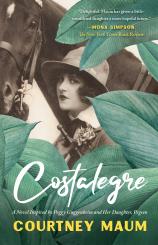Costalegre
Review
Costalegre
Someone with a far greater knowledge of Surrealist and Dadaist art and literature than I have would likely have great fun with Courtney Maum’s new novel, COSTALEGRE, since they’d more easily be able to connect the dots between the fictional characters she has created and their historical antecedents. The good news, however, is that whether or not you’re already familiar with the basis of the book, there’s plenty of historical background, lush and evocative setting, and emotional resonance to satisfy any reader.
COSTALEGRE is loosely based on the life of the heiress and bohemian art collector and patron Peggy Guggenheim, as well as her daughter, Pegeen. The Peggy Guggenheim character (named Leonora in the book) has just --- in the wake of a rejection of her art collection by the French artistic establishment and in the mounting Nazi threat --- put her sizeable art collection on a ship across the Atlantic and brought a close circle of so-called degenerate artists with her to a remote retreat on the coast of Mexico. In real life, Peggy Guggenheim did something similar, though the Mexican setting is strictly Maum’s imagination at work, creating a verdant yet somehow threatening setting that helps isolate her characters and raise their emotional stakes.
"COSTALEGRE is a fascinating novel, not only because of its exploration of a particular artistic and historic moment, but also as a portrait of a young woman desperately trying to find herself in relation to others but encountering disillusion at every turn."
Leonora’s daughter, Lara, is 15 as the novel’s events unfold. She fashions herself something of an artist as well, although virtually none of the artists who have accompanied Lara and her mother to Mexico take Lara or her artistic ambitions at all seriously. Unlike the artists, who are nearly all painfully self-absorbed, Lara takes it upon herself to get to know the servants who work at the home where they’re staying, and to study the Spanish language as well as the flora and fauna of the surrounding jungle. Much as she’s cognizant of her immediate surroundings in a way that the adults in her circle are not, she is also uneasily aware of the growing tensions and danger in Europe, though her fears stem in large part from uncertainty about the safety of her father and brother, who are in Switzerland.
As the time in Costalegre drags on, as the natural environment feels more and more unnatural and threatening, Lara struggles --- in the pages of the diary that serves as the novel’s narrative structure --- to define herself as an artist, as a nascent adult, and as a daughter despite her mother’s repeated indifference to her well-being or even her safety. Lara is both fascinated by the artists and writers who have formed this insular community and repelled by them, particularly since she recognizes that she can never truly compete with them for her mother’s attention or affection. “I hope that ship sinks, I hope it burns, that’s the only thing there is,” Lara writes in her diary. “I’d sink her awful collection, and then what would she do? There’d be nothing left to fawn over and boast about and move around the world for and maybe she would be emptied enough to finally mother me.”
COSTALEGRE is a fascinating novel, not only because of its exploration of a particular artistic and historic moment, but also as a portrait of a young woman desperately trying to find herself in relation to others but encountering disillusion at every turn. Lara’s observations, musings, dreams and sketches give readers a glimpse of her inner life that, one realizes, offers far more insight into this character than Lara’s mother ever even cared to have.
Reviewed by Norah Piehl on July 19, 2019
Costalegre
- Publication Date: July 14, 2020
- Genres: Fiction, Historical Fiction
- Paperback: 240 pages
- Publisher: Tin House Books
- ISBN-10: 1951142012
- ISBN-13: 9781951142018




